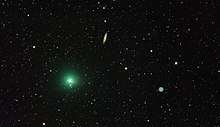41P/Tuttle–Giacobini–Kresák
 Comet 41P/Tuttle–Giacobini–Kresák on 2017, 3 March near the galaxy Messier 108 and Owl Nebula. | |
| Discovery | |
|---|---|
| Discovered by |
Horace Parnell Tuttle Michel Giacobini Ľubor Kresák |
| Discovery date | May 3, 1858 |
| Alternative designations |
1858 III; 1907 III; 1951 IV; 1962 V; 1973 VI; 1978 XXV; 1990 II |
| Orbital characteristics A | |
| Epoch | March 6, 2006 |
| Aphelion | 5.122 AU |
| Perihelion | 1.048 AU |
| Semi-major axis | 3.085 AU |
| Eccentricity | 0.6604 |
| Orbital period | 5.419 a |
| Inclination | 9.2294° |
| Earth MOID | 0.13 AU (19,000,000 km)[1] |
| Jupiter MOID | 0.48 AU (72,000,000 km)[1] |
| Last perihelion |
November 12, 2011[2][3] (not observed)[4] June 11, 2006[2][3] |
| Next perihelion | 2017-Apr-12[5] |
41P/Tuttle–Giacobini–Kresák is a periodic comet in the Solar System. The comet nucleus is estimated to be 1.4 kilometers in diameter.[1]
Discovered by Horace Parnell Tuttle on May 3, 1858, and re-discovered independently by Michel Giacobini and Ľubor Kresák in 1907 and 1951 respectively, it is a member of the Jupiter family of comets.
2006 apparition
As of June 1, 2006, Comet 41P was a 10th magnitude object for telescopes, located on the Cancer-Leo border, with a predicted maximum of about 10 at perihelion on June 11. This comet is of interest as it has been noted to flare dramatically. In 1973 the flare was 10 magnitudes brighter than predicted, reaching easy naked-eye visibility at apparent magnitude 4.[6] However, by June 22, the comet had diminished to about magnitude 11, having produced no flare of note.
2011 apparition
The comet was not observed during the 2011 unfavorable apparition[4] since the perihelion passage occurred when the comet was on the far side of the Sun.
2017 apparition
41P was recovered on November 10, 2016 at apparent magnitude 21 by Pan-STARRS.[5] On April 1, 2017 the comet will pass 0.142 AU (21,200,000 km; 13,200,000 mi) from the Earth.[7] The comet is expected to brighten to around magnitude 7 and be visible in binoculars.[2][8]
References
- 1 2 3 "JPL Small-Body Database Browser: 41P/Tuttle-Giacobini-Kresak" (August 27, 2006 last obs). Jet Propulsion Laboratory. Retrieved 2010-02-28.
- 1 2 3 Seiichi Yoshida (December 31, 2006). "41P/Tuttle-Giacobini-Kresak". Seiichi Yoshida's Comet Catalog. Retrieved 2010-02-28.
- 1 2 Syuichi Nakano (May 7, 2008). "41P/Tuttle-Giacobini-Kresak (NK 1616)". OAA Computing and Minor Planet Sections. Retrieved 2010-02-28.
- 1 2 Seiichi Yoshida (July 22, 2011). "41P/Tuttle-Giacobini-Kresak (2011)". Seiichi Yoshida's Comet Catalog. Retrieved 2012-02-18.
- 1 2 "41P/Tuttle-Giacobini-Kresak Orbit". Minor Planet Center. Archived from the original on June 16, 2014. Retrieved 2014-06-16.
- ↑ 41P/Tuttle-Giacobini-Kresák (Kronk)
- ↑ "JPL Close-Approach Data: 41P/Tuttle-Giacobini-Kresak" (August 27, 2006 last obs). Archived from the original on December 13, 2012. Retrieved 2012-02-22.
- ↑ Bob King (2017-01-04). "Bright Comet Prospects for 2017". Sky & Telescope. Retrieved 2017-03-02.
External links
- Orbital simulation from JPL (Java) / Horizons Ephemeris
- 41P/Tuttle-Giacobini-Kresak at the Minor Planet Center's Database
- 41P at Kronk's Cometography
+
| Numbered comets | ||
|---|---|---|
| Previous 40P/Väisälä |
41P/Tuttle–Giacobini–Kresák | Next 42P/Neujmin |

